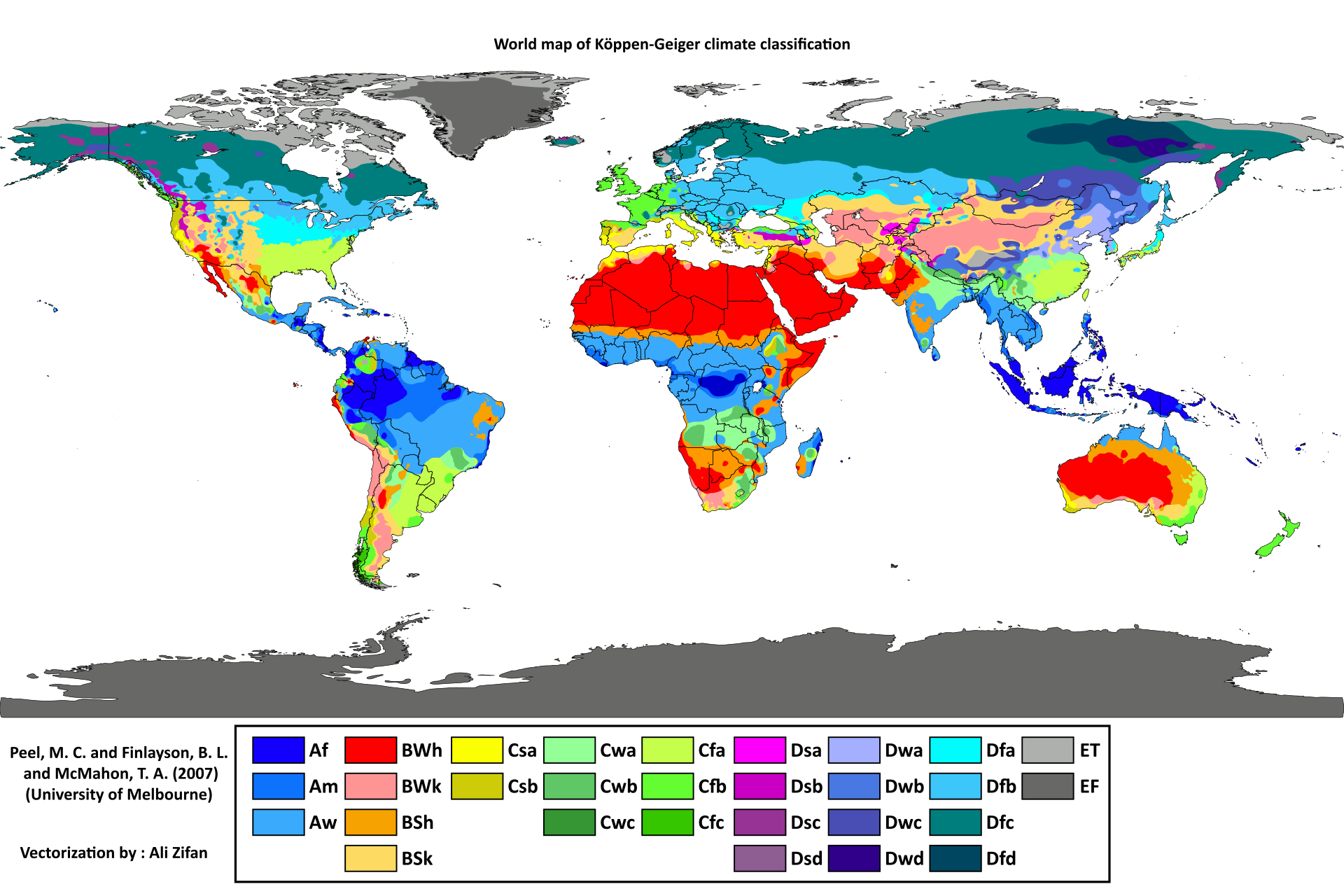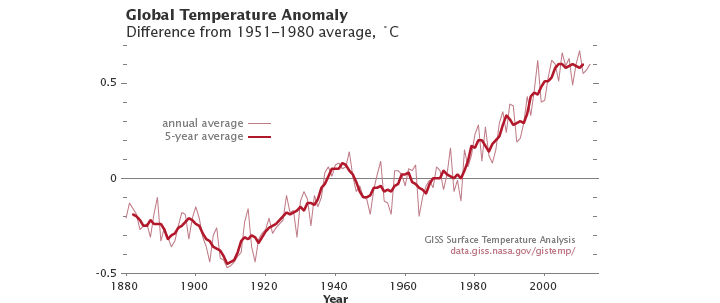Difference Between Climate and Temperature
What is Climate?
Climate represents the average conditions of the atmosphere sustained over a long period of time. This includes temperature, air pressure, and atmospheric composition. Climate affects ecology and landscape since it has a significant effect on precipitation.
Climate vs. weather
Although climate and weather are related, they are different. Weather is the conditions of the atmosphere at any time and over a few days. Weather includes all atmospheric phenomena including precipitation, wind, clouds, and storm systems. Weather is constantly changing on a timescale of hours to days. Climate, on the other hand, represents the average conditions of the atmosphere over centuries to thousands, even millions, of years.

Types of climate
Climate varies across the planet, largely due to differences in the angle at which the sun’s rays are hitting the planet’s surface and the distribution of moisture across the planet. The five main types of climate regimes include the following: temperate, continental, tropical, dry, and polar climates.
Temperate climates are found in the American southeast and in places like the Mediterranean Basin and eastern China. Temperate climates tend to have warm, sometimes hot, summers and mild winters.
Continental climates are found in places like the northeastern United States and Russia. They are characterized by hot summers and cold winters. They are common in the interior regions of continents. They tend to be relatively dry and their distance from the ocean, which tends to moderate temperature changes, makes the contrasts between summer and winter starker.
Tropical climates are characterized by warm temperatures and high precipitation. They usually occur along the equator in places such as equatorial Africa, southeast Asia, and northern South America.
Arid climates are characterized by high temperatures but very low precipitation rates. Regions with arid climates include the Sahara Desert in Africa, the American Southwest, and northwestern China around the Tarim Basin.
Polar climates typically contain very low temperatures during both summer and winter. Snow and ice are often year-round in regions with these climates. Polar climates are most common in the northern and southern polar regions, Greenland and Antarctica respectively.
What is Climate change?
Climate changes in the past are primarily studied through methods such as ice cores and dendrochronology. On the central plains of Greenland, annual layers of ice accumulate over time at a uniform rate due to regular levels of snow fall. As these annual layers build up, ice becomes compacted creating air bubbles that are isolated from the rest of the atmosphere. Since the air in the bubbles is isolated, it contains the same chemical composition of the atmosphere at the time that the air became sealed due to compaction. This allows the chemical composition of the ancient atmosphere to be known which can allow for the nature of the ancient climate to be predicted.
The atmospheric composition of the atmosphere is important because of how it drives climate. Another important way to study past climate, especially in dry, temperate regions, is through dendrochronology. Using dendrochronology, tree rings from different trees are compared to create a chronology of dry seasons and growing seasons. During wet seasons, tree rings will be thicker, while they will be thinner during dry seasons. If the tree rings of living trees can be matched with those of ancient, dead trees, a record can be created recording precipitation levels going back thousands of years.
Most scientists studying climate change study the modern phenomenon of global warming. In this phenomenon, global average temperature is steadily increasing due to the increase of carbon dioxide in the atmosphere, a gas known for its ability to trap heat.

What is Temperature?
Temperature is a physical quantity. At a fundamental level, temperature is related to the kinetic energy of atoms and molecules. Temperature is very important in scientific fields including chemistry, physics, earth science, and medicine.
Measuring temperature
The two most common ways in science for measuring temperature are the Celsius scale and the Kelvin scale. In the Celsius scale, 0 degrees is the melting/freezing point of water and 100 degrees is the boiling point of water. Within the Kelvin scale, 0 is absolute zero, the lowest temperature that is theoretically possible.
Temperature of the universe
Temperature is an important physical aspect of the universe, as a result, it has implications throughout the physical sciences. Right after the Big Bang, the universe had a temperature of about 1032 Kelvins. As the universe expanded, it eventually cooled to about 3 Kelvins which it is today. The temperature of any point in the universe is generally very low. Exceptions to this rule include stars where nuclear fusion produces enough energy for higher temperatures. Other places that are islands of high temperature in the universe are planetary atmospheres with heat trapping gases such as carbon dioxide.
Similarities between Climate and Temperature
Climate and temperature are both related to heat. Changes in the average atmospheric temperature also usually result in climate changes. Historical climate and historical temperatures are also both usually measured indirectly.
Differences between Climate vs. Temperature
Although there are similarities between climate and temperature, there are also significant differences which include the following.
- Temperature is a property of the universe whereas climate is primarily a feature of the atmosphere of a planet or a region on a planet’s surface.
- Temperature causes climate whereas climate is the result of temperature.
- A discussion of climate always involves a discussion of temperature, but a discussion of temperature does not always involve a discussion of climate.
- Temperature is a physical quantity whereas climate is a physical qualitative state of the atmosphere.
Climate vs. Temperature: Comparison Chart

Summary of Climate vs. Temperature
The climate represents the average properties of the atmosphere over an extended period of time. This includes temperature range, precipitation rates, and wind, among other factors. Climate can vary from region to region on a planet based on the local angle of insolation and distribution of moisture. Some main climate types include temperate, continental, tropical, arid, and polar climates. Climate change is primarily studied through methods such as ice cores and dendrochronology. Temperature is a physical quantity related to the motion of atoms and molecules. The two main temperature measurement scales used in science are Celsius and Kelvin. In Celsius, 0 degrees is the melting/freezing point of water. In Kelvins, 0 represents the coldest theoretically possible temperature. Most of the universe is about 3 Kelvins and higher temperature regions of the universe include stars and planetary atmospheres. Climate and temperature are similar in that they both are related to heat and they both are connected since climate change will occur at the same time as changes in average temperature. Differences include the fact that climate is primarily a property of atmospheres while temperature is a property of the entire universe. Furthermore, temperature is a cause of climate and is always involved in a discussion of climate whereas a discussion of temperature doesn’t always involve a discussion of climate. Also, temperature is a physical quantity whereas climate is a qualitative physical state that describes the atmosphere.
- Difference Between Environmental Performance Index and Development - November 24, 2023
- Difference Between Environmental Intervention and Development - November 8, 2023
- Difference Between Eco Efficiency and Eco Effectiveness - September 18, 2023
Search DifferenceBetween.net :
Leave a Response
References :
[0]Image credit: https://en.wikipedia.org/wiki/Climate_of_Launceston,_Tasmania#/media/File:World_K%C3%B6ppen_Classification_(with_authors).svg
[1]Image credit: https://earthobservatory.nasa.gov/images/82908/global-temperature-anomaly-18802013
[2]“What Are Climate and Climate Change?” 2011. NASA. Available at: https://www.nasa.gov/audience/forstudents/5-8/features/nasa-knows/what-is-climate-change-58.html
[3]Means, Tiffany. 2019. Koppen Climate Classification System. ThoughtCo. Available at: https://www.thoughtco.com/the-worlds-koppen-climates-4109230
[4]Alley, Richard B. The Two-Mile Time Machine: Ice Cores, Abrupt Climate Change, and Our Future-Updated Edition. Princeton University Press, 2014.
[5]Harris, Daniel C. "Charles David Keeling and the story of atmospheric CO2 measurements." (2010): 7865-7870.
[6]Ogden, John. "Dendrochronology and dendroecology—an introduction." New Zealand Journal of Ecology 3 (1980): 154-156.
[7]“The Planet’s Temperature is Rising.” 2016. Union of Concerned Scientists. Available at: https://www.ucsusa.org/global-warming/science-and-impacts/science/temperature-is-rising
